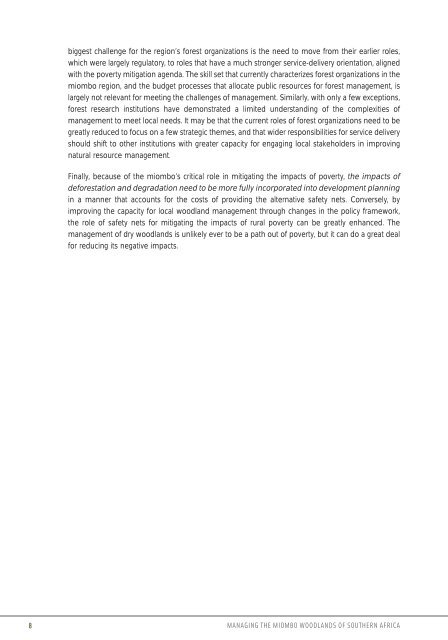Managing the Miombo Woodlands of Southern Africa - PROFOR
Managing the Miombo Woodlands of Southern Africa - PROFOR
Managing the Miombo Woodlands of Southern Africa - PROFOR
You also want an ePaper? Increase the reach of your titles
YUMPU automatically turns print PDFs into web optimized ePapers that Google loves.
iggest challenge for <strong>the</strong> region’s forest organizations is <strong>the</strong> need to move from <strong>the</strong>ir earlier roles,<br />
which were largely regulatory, to roles that have a much stronger service-delivery orientation, aligned<br />
with <strong>the</strong> poverty mitigation agenda. The skill set that currently characterizes forest organizations in <strong>the</strong><br />
miombo region, and <strong>the</strong> budget processes that allocate public resources for forest management, is<br />
largely not relevant for meeting <strong>the</strong> challenges <strong>of</strong> management. Similarly, with only a few exceptions,<br />
forest research institutions have demonstrated a limited understanding <strong>of</strong> <strong>the</strong> complexities <strong>of</strong><br />
management to meet local needs. It may be that <strong>the</strong> current roles <strong>of</strong> forest organizations need to be<br />
greatly reduced to focus on a few strategic <strong>the</strong>mes, and that wider responsibilities for service delivery<br />
should shift to o<strong>the</strong>r institutions with greater capacity for engaging local stakeholders in improving<br />
natural resource management.<br />
Finally, because <strong>of</strong> <strong>the</strong> miombo’s critical role in mitigating <strong>the</strong> impacts <strong>of</strong> poverty, <strong>the</strong> impacts <strong>of</strong><br />
deforestation and degradation need to be more fully incorporated into development planning<br />
in a manner that accounts for <strong>the</strong> costs <strong>of</strong> providing <strong>the</strong> alternative safety nets. Conversely, by<br />
improving <strong>the</strong> capacity for local woodland management through changes in <strong>the</strong> policy framework,<br />
<strong>the</strong> role <strong>of</strong> safety nets for mitigating <strong>the</strong> impacts <strong>of</strong> rural poverty can be greatly enhanced. The<br />
management <strong>of</strong> dry woodlands is unlikely ever to be a path out <strong>of</strong> poverty, but it can do a great deal<br />
for reducing its negative impacts.<br />
8 MANAGING THE MIOMBO WOODLANDS OF SOUTHERN AFRICA

















